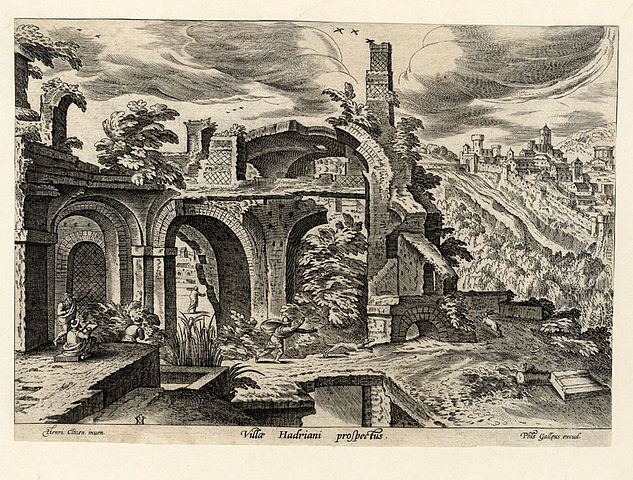Hadrian’s Religious Policy: An Architectural Perspective
By Chelsie Weidele Brines
Master’s Thesis, East Carolina University, 2015

Abstract: This thesis argues that the emperor Hadrian used vast building projects as a means to display and project his distinctive religious policy in the service of his overarching attempt to cement his power and rule. The undergirding analysis focuses on a select group of his building projects throughout the empire and draws on an array of secondary literature on issues of his rule and imperial power, including other monuments commissioned by Hadrian. An examination of Hadrian’s religious policy through examination of his architectural projects will reveal the catalysts for his diplomatic success in and outside of Rome. The thesis discusses in turn: Hadrian’s building projects within the city of Rome, his villa at Tibur, and various projects in the provinces of Greece and Judaea. By juxtaposing analysis of Hadrian’s projects in Rome and Greece with his projects and actions in Judaea, this study seeks to provide a deeper understanding of his religious policy and the state of Roman religion in his times than scholars have reached to date.
Introduction: Hadrian began his reign at the peak of Roman expansion. Hadrian halted expansion upon his accession, withdrew from certain recently conquered areas, and began an initiative of diplomacy and unification. The undergirding analysis focuses on a select group of his building projects throughout the empire and draws on an array of secondary literature on issues of his rule and imperial power, including other monuments commissioned by Hadrian. An examination of Hadrian’s religious policy through examination of his architectural projects will reveal the catalysts for his diplomatic success in and outside of Rome. The thesis discusses in turn: Hadrian’s building projects within the city of Rome, his villa at Tibur, and various projects in the provinces of Greece and Judaea.

 The building projects of Rome and Greece were selected based on their visibility to the broadest segment of the Roman population and the availability of extant primary documents. By juxtaposing analysis of Hadrian’s projects in Rome and Greece with his projects and actions in Judaea, this study seeks to provide a deeper understanding of his religious policy and the state of Roman religion in his times than scholars have reached to date. This thesis argues that the emperor Hadrian used vast building projects as a means to display and project his distinctive religious policy in the service of his overarching attempt to cement his power and rule. Hadrian’s policy is unique in that his policy development, stemming from his intentions to unify Rome while still embracing the past, and the monuments themselves contribute greatly to his success.
The building projects of Rome and Greece were selected based on their visibility to the broadest segment of the Roman population and the availability of extant primary documents. By juxtaposing analysis of Hadrian’s projects in Rome and Greece with his projects and actions in Judaea, this study seeks to provide a deeper understanding of his religious policy and the state of Roman religion in his times than scholars have reached to date. This thesis argues that the emperor Hadrian used vast building projects as a means to display and project his distinctive religious policy in the service of his overarching attempt to cement his power and rule. Hadrian’s policy is unique in that his policy development, stemming from his intentions to unify Rome while still embracing the past, and the monuments themselves contribute greatly to his success.
Click here to read this thesis from East Carolina University
Sponsored Content


Hadrian’s Religious Policy: An Architectural Perspective
By Chelsie Weidele Brines
Master’s Thesis, East Carolina University, 2015
Abstract: This thesis argues that the emperor Hadrian used vast building projects as a means to display and project his distinctive religious policy in the service of his overarching attempt to cement his power and rule. The undergirding analysis focuses on a select group of his building projects throughout the empire and draws on an array of secondary literature on issues of his rule and imperial power, including other monuments commissioned by Hadrian. An examination of Hadrian’s religious policy through examination of his architectural projects will reveal the catalysts for his diplomatic success in and outside of Rome. The thesis discusses in turn: Hadrian’s building projects within the city of Rome, his villa at Tibur, and various projects in the provinces of Greece and Judaea. By juxtaposing analysis of Hadrian’s projects in Rome and Greece with his projects and actions in Judaea, this study seeks to provide a deeper understanding of his religious policy and the state of Roman religion in his times than scholars have reached to date.
Introduction: Hadrian began his reign at the peak of Roman expansion. Hadrian halted expansion upon his accession, withdrew from certain recently conquered areas, and began an initiative of diplomacy and unification. The undergirding analysis focuses on a select group of his building projects throughout the empire and draws on an array of secondary literature on issues of his rule and imperial power, including other monuments commissioned by Hadrian. An examination of Hadrian’s religious policy through examination of his architectural projects will reveal the catalysts for his diplomatic success in and outside of Rome. The thesis discusses in turn: Hadrian’s building projects within the city of Rome, his villa at Tibur, and various projects in the provinces of Greece and Judaea.
Click here to read this thesis from East Carolina University
Sponsored Content